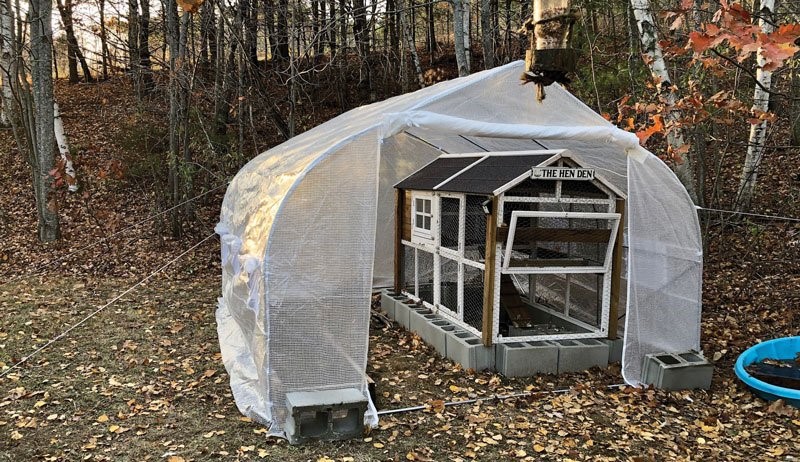Heating Your Greenhouse with a Compost Heap or Chicken Body Heat

Rhiannon Phillips of Mountains Gourmet says there’s no need to hibernate during winter when you’ve got a cosy greenhouse.
As the winter frost blankets the landscape and temperatures plummet, avid gardeners and horticulturists face the challenge of maintaining optimal growing conditions for their beloved plants. Greenhouses, with their controlled environments, offer a sanctuary for nurturing plants throughout the whole year. However, the cost of heating these spaces during colder months can be substantial and inefficient. Thankfully, there are eco-friendly, multifunctional alternatives that harness nature’s warmth, such as utilising a compost heap or harnessing the heat generated by chickens. In this post, we will explore these innovative approaches and discuss why heating your growing space during winter is essential.
Why Heat Your Growing Space During Winter?
- Extending the Growing Season: By heating your greenhouse during winter, you can extend the growing season significantly. This means you can cultivate a wider variety of crops, produce an abundant harvest, and enjoy fresh, homegrown produce even when outdoor conditions are unfavorable.
- Protecting Delicate Plants: Many plants, especially tender or exotic varieties, cannot withstand the harsh temperatures of an Australian winter. A heated greenhouse provides a protective cocoon that shields these plants from frost, ensuring their survival and healthy growth.
- Creating Ideal Growing Conditions: Most plants require specific temperature ranges to thrive. Maintaining optimal environmental conditions can lead to faster growth, increased yields, and healthier plants. Heating your greenhouse allows you to regulate the temperature and create an environment that fosters growth, even when it’s freezing outside.
Harness those microbe byproducts to create a warm seedling growing environment AND create lovely compost.
Harnessing Nature’s Warmth: Compost Heap Heating
One innovative method to heat a greenhouse is by utilising the heat generated by a compost heap. Composting is a natural process where organic materials break down, producing heat as a byproduct. Here’s how you can harness this heat:
- Designing Your Compost Heap: Construct a compost heap or bin within or near your greenhouse. Optimal sizing and placement are crucial to ensure efficient heat transfer.
- Composting Materials: Use a balanced mix of organic materials such as kitchen scraps, yard waste, and animal manure. Layer them to facilitate decomposition and the release of heat.
- Heat Distribution: Install a system of pipes or ducts within the compost heap to channel the hot air into and around the greenhouse. As the compost decomposes, warm air circulates, providing a natural and sustainable source of heat.
Harnessing Nature’s Warmth: Chicken Body Heat

If you keep chickens as livestock, you can capitalise on their body heat to warm your greenhouse during winter (and keep the girls warm!) Chickens naturally generate heat, and when harnessed correctly, it can help regulate the temperature within your growing space:
- Coop Placement: Position the chicken coop close to or within the greenhouse, ensuring that it’s well-insulated. This proximity allows the heat generated by the chickens to transfer into the greenhouse.
- Ventilation Considerations: Adequate ventilation is crucial to maintaining a healthy environment for both the chickens and the plants. It helps regulate temperature, remove excess moisture, and prevent the buildup of harmful gases. It is a good idea to allow your chooks access to the outdoors during the day as greenhouses can heat up in the sun quickly.
- Thermal Mass: Incorporate materials with high thermal mass, such as stone or concrete, within your greenhouse. These materials absorb and store heat efficiently, helping to maintain a stable temperature, especially during cold nights.
That’s a wrap!
Heating your greenhouse during winter is a wise investment for any dedicated gardener. Not only does it extend the growing season and protect delicate plants, but it also allows you to create an environment that fosters healthy growth and increased yields. By harnessing the heat generated by a compost heap or utilising the body heat of chickens, you can not only reduce your carbon footprint but also tap into sustainable and cost-effective methods of warming your growing space. So, embrace nature’s warmth and embark on a fruitful winter gardening journey in your greenhouse.
Remember, when winter arrives, you don’t have to let your green thumb hibernate. Let nature be your ally and keep your greenhouse thriving throughout the colder months.
If you would like to learn more and put these tools in place on your property book a consult or attend the ‘Winter is Here’ workshop in June – see the workshops tab for bookings on the Mountains Gourmet website.



